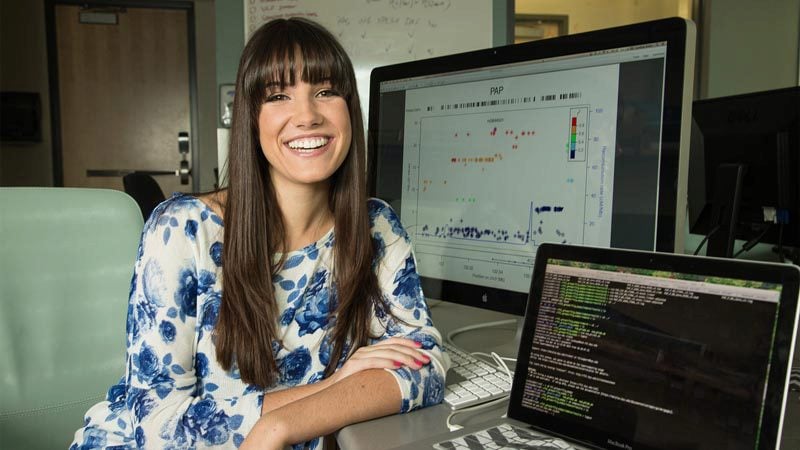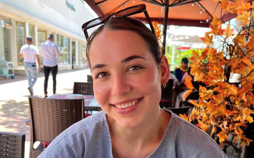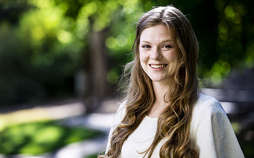Of Needles and Haystacks
June 2016
The human genome consists of 3.2 billion nucleotides - the tiny DNA building blocks that form a chromosome - all arrayed in precise sequences. If just a handful of those nucleotides are out of place or mismatched, it can result in a debilitating genetic disorder. Imagine the task of sorting the out-of-sequence nucleotides from among those 3.2 billion - finding a needle in a haystack, by comparison, might not seem so difficult.
Lyndsay Staley of central California doesn’t have a genetic disease, and she didn’t come to Brigham Young University determined to study rare diseases either. When she was younger, she knew a family with three children who all had a rare condition called mitochondrial disease, and that was enough to make her curious.
When her BYU roommate needed to meet with their professor, Lyndsay went along for moral support. Realizing that their professor, Dr. John Kauwe, oversaw a laboratory for genetic research, Lyndsay couldn’t help changing the subject.
“I asked Dr. Kauwe, ‘Would you be interested in researching mitochondrial disease?’” Lyndsay remembers. “And he replied, ‘How about you join my lab and I’ll help you do it?’ And I thought, ‘But I’m just a freshman.’”
A Key Difference
That was how Lyndsay stumbled upon a key difference between BYU and other schools: undergraduate mentorships. Thanks to donor-funded mentorships, undergrads at BYU get to participate in research that is usually reserved for graduate students.
“Being at BYU has given me so many experiences that I couldn’t have received at Yale or Columbia,” says Lyndsay, who once dreamed of attending an Ivy League school but now realizes that a BYU education has its perks. “At other schools, undergraduates aren’t allowed to do the kind of research I’ve done in the lab. After my first year at BYU, I realized I was exactly where Heavenly Father wanted me.”
On top of that, her mentorship (and a donor-funded scholarship) helped her cover the cost of school - something she hadn’t been sure she could do on her own. “My parents weren’t in the best financial situation, so they weren’t able to help me,” she says. “I couldn’t have done it without either scholarships or being in debt.”
The Fabric of Life
How do you find a needle in a massive haystack of DNA? Thanks to advances in technology, scientists have developed a new way to sift and explore these vast troves of data: bioinformatics, which uses computer models to determine where the misplaced links are on the chain. For Lyndsay, bioinformatics quickly became her passion.
“I don’t even like programming that much,” she admits. “And I don’t see myself behind a computer every day, but I know programming is what allows me to do what I do. It allows me to break the data down and analyze it.”
Now her work has resulted in published research and opportunities for graduate school. And Lyndsay says the blessings aren’t just academic. Whereas others have used science to justify disbelief, she says her experience in the lab has brought her closer to God.
“When I see how these tiny changes in cells can cause huge effects that change people’s lives, I feel like there has to be something behind it,” she says. “If you go into science with a testimony and nourish it, it will help you to be a better scientist, I think. Heavenly Father will help you understand a little of what he understands.”
With her bachelor’s degree behind her today, Lyndsay’s ready to dive headfirst into graduate school at BYU in the fall. And she’s already back in the lab with Dr. Kauwe, piecing together a picture so complex it makes a 1,000-piece jigsaw puzzle look like child’s play. Most important, she knows that by making sense out of what she sees in the lab, she can potentially aid people who have nowhere else to turn.
“There are over 7,000 rare genetic diseases out there,” she says. “When I think about kids dying from diseases by the time they’re 4, it just doesn’t seem fair - and that’s what keeps me going. Some of these might be cured quickly, but because they’re so rare, nobody’s studying them. I know I can’t cure them all even if I want to, but once I’ve done the research, I can hopefully help.”
Give to BYU



